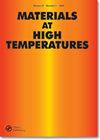采用常规工艺或增材制造技术生产的AISI 316钢蠕变响应的统一本构方法
IF 0.9
4区 材料科学
Q4 MATERIALS SCIENCE, MULTIDISCIPLINARY
引用次数: 0
摘要
对AISI 316和AISI 316l的蠕变响应进行了分析,以提供材料行为的连贯图像,适用于传统的锻造钢和增材制造钢。文献证据被考虑。分析表明,在AISI 316和316l (N)中,蠕变暴露过程中析出的细颗粒分布应该被考虑在内。最近专门为颗粒强化合金开发的一个模型,成功地用于描述AISI 316和316l (N)的最小蠕变速率依赖于外加应力。然后,将同一组本构方程与复合模型相结合,用于描述通过增材制造生产的AISI 316l测试获得的蠕变数据。与变形材料的主要区别在于,增材制造合金的显微组织由细胞(软区)和厚壁(硬区)组成。本文章由计算机程序翻译,如有差异,请以英文原文为准。
A unified constitutive approach for creep response of AISI 316 steel produced by conventional technologies or additive manufacturing techniques
ABSTRACT The creep response of AISI 316 and AISI 316 L was analysed to provide a coherent picture of the material behaviour, valid for both conventional wrought and additively manufactured steels. Literature evidences were considered. The analysis demonstrated that the presence of a fine distribution of particles, precipitated during creep exposure in both AISI 316 and 316 L(N), should be taken into account. A recent model, expressly developed for particle-strengthened alloys, was successfully used to describe the minimum creep rate dependence on applied stress for AISI 316 and 316 L(N). The same set of constitutive equations, in combination with the composite model, was then used for describing creep data obtained by testing the AISI 316 L produced by additive manufacturing. The main difference with wrought materials was that the microstructure of the additively manufactured alloy was composed by cells (soft zones) and thick walls heavily decorated with ultrafine oxide particles (hard zones).
求助全文
通过发布文献求助,成功后即可免费获取论文全文。
去求助
来源期刊

Materials at High Temperatures
工程技术-材料科学:综合
CiteScore
1.90
自引率
15.40%
发文量
58
审稿时长
>12 weeks
期刊介绍:
Materials at High Temperatures welcomes contributions relating to high temperature applications in the energy generation, aerospace, chemical and process industries. The effects of high temperatures and extreme environments on the corrosion and oxidation, fatigue, creep, strength and wear of metallic alloys, ceramics, intermetallics, and refractory and composite materials relative to these industries are covered.
Papers on the modelling of behaviour and life prediction are also welcome, provided these are validated by experimental data and explicitly linked to actual or potential applications. Contributions addressing the needs of designers and engineers (e.g. standards and codes of practice) relative to the areas of interest of this journal also fall within the scope. The term ''high temperatures'' refers to the subsequent temperatures of application and not, for example, to those of processing itself.
Materials at High Temperatures publishes regular thematic issues on topics of current interest. Proposals for issues are welcomed; please contact one of the Editors with details.
 求助内容:
求助内容: 应助结果提醒方式:
应助结果提醒方式:


